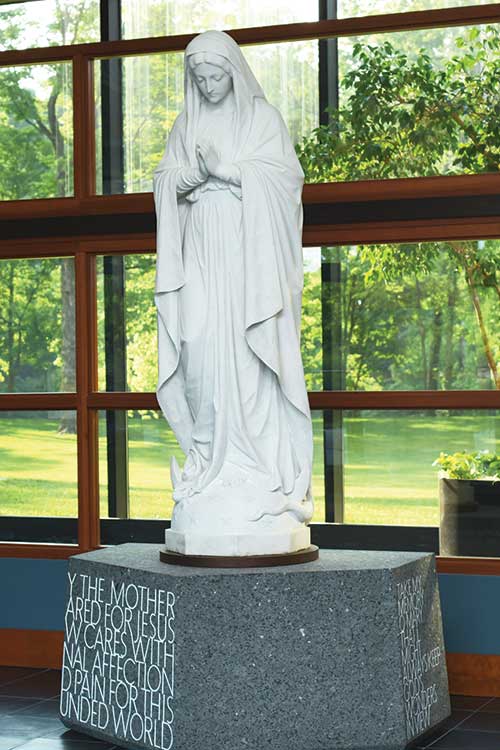Think again

“Mary did this to me,” Father Joe Kozar, S.M. ’69, explained to the emergency personnel examining the blood-spurting gash on his forehead. But St. Joseph was also to blame. It had been a statue of that carpenter that fell behind Kozar’s desk. Kozar, who serves as assistant rector in the UD’s Office for Mission and Rector, was retrieving the statue when he bumped into the sharp metal bottom edge of a shrine holding a black-cloaked statue of Mary that hangs next to the desk.
Kozar has a quirky sense of humor.
Explaining his role in new faculty orientation, he said, “When I introduce the Catholic, Marianist identity of the University, I always include jokes. One new faculty member told me that the day was so filled with content that she really only remembered my talk because she laughed.”
He may not have learned to tell jokes
from the late Father Norbert Burns, S.M. ’45 but did get advice on orienting people to campus culture. “He told me,” Kozar said, “he had two questions for new hires: ‘Are you happy? What can we do to make you happy?’
“At first I thought that was stupid.
“Then, I thought again. Being happy is a good reason to remain at a place.”
“Being happy is a good reason to remain at a place.”
Burns believed that to teach people we need to go where they are before we can bring them to where we are. That also works in terms of preserving and promoting UD’s identity. Among Kozar’s activities is joining with other rector’s office members in hosting new employee dinners. Faculty and staff new to campus learn of UD’s mission. And “they get a pin,” Kozar added, maybe jokingly.
“They also get to meet other new people in a meal setting and have interesting conversations across units.”
One hallmark of Marianist ministry is faith formation as a lifelong process. By the time faculty are in their second year, they have assimilated something of the institution’s mission. So a second-year, daylong retreat is offered to further that interest. “There are fewer presentations than there used to be, but more participation by faculty in groups,” Kozar said. “That’s modeling what we want our students to do,
participate.”
Gearing back up in post-pandemic times, in addition to dinners and retreats, are the Founder Seminars, semester-long explorations into particular aspects of the Marianist founders. The concluding pilgrimage to France and Spain of the last pre-COVID seminar included the celebration of the beatification of Adèle de Batz de Trenquelléon in Agen. Kozar noted that the English language song sung at the celebration, composed by a participant, Nick Cardilino ’89 of UD’s Campus Ministry, was based on the words of Adèle: “O my God, my heart is too small to love you, but I will see to it that you are loved by so many hearts that their love will compensate for the weakness of mine.”
Mary Immaculata
“When I was a scholastic at Mount St. John,” Father Joe Kozar, S.M. ’69, said, “we had an ornate chapel in the administration building. Above the altar, facing out over the congregation, was a statue of Mary, so high up she seemed small.”
One could climb up behind the statue and not only realize that she was larger than she seemed but also get a great view. “Because I could,” Kozar said, “I did.” The lighting in the chapel was weak. Mary was illuminated by two fluorescent bulbs. “She was green,” Kozar said.
Today Mary Immaculata is a highly visible white, nearly 1,000-pound, 5’6” statue on a 2-foot tall base, restored and recently dedicated in the lobby of Curran Place, with views, not of young Marianist scholastics, but of UD’s solar prairie and Old River Park.